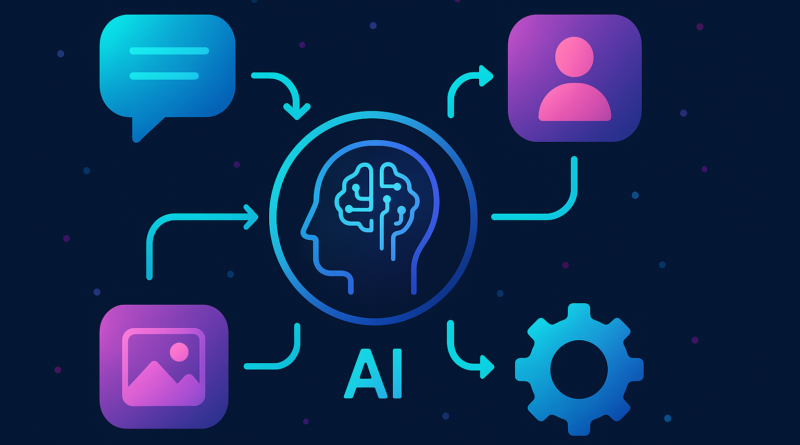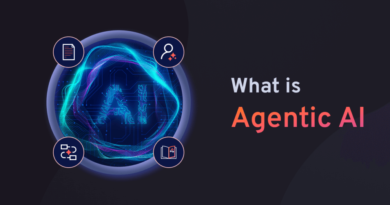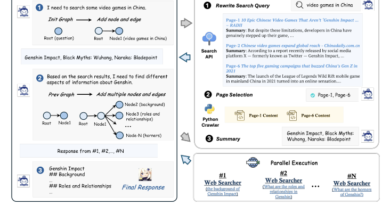Top 5 No-Code AI Platforms to Build Powerful AI Agents (2025 Guide)
Introduction: The Rise of No-Code AI Agent Builders
In 2025, the AI landscape continues to evolve rapidly, but one thing has become clear—you don’t need to be a machine learning engineer to build intelligent AI agents anymore. The emergence of no-code AI platforms has democratized access to advanced AI tooling, enabling individuals from non-technical backgrounds to build, deploy, and manage AI agents for a wide variety of use cases—from personal productivity assistants to enterprise-grade automation bots.
Whether you’re a solo entrepreneur, a product manager, or a marketing strategist, no-code tools allow you to create context-aware, autonomous, and intelligent AI systems through intuitive drag-and-drop interfaces, prebuilt components, and seamless integrations.
In this blog, we’ll deep-dive into the top 5 no-code AI platforms to build powerful AI agents in 2025, analyzing their capabilities, core features, and ideal use cases to help you choose the best fit.
1. PySpur – Visual, Node-by-Node AI Agent Development
Overview:
PySpur is a flexible, open-source no-code platform that allows users to create AI agents using a node-based visual programming interface. Designed for both novices and AI developers who want rapid prototyping capabilities, PySpur is known for its “human-in-the-loop” agent design, which allows manual intervention in automated workflows—a rare and powerful feature.
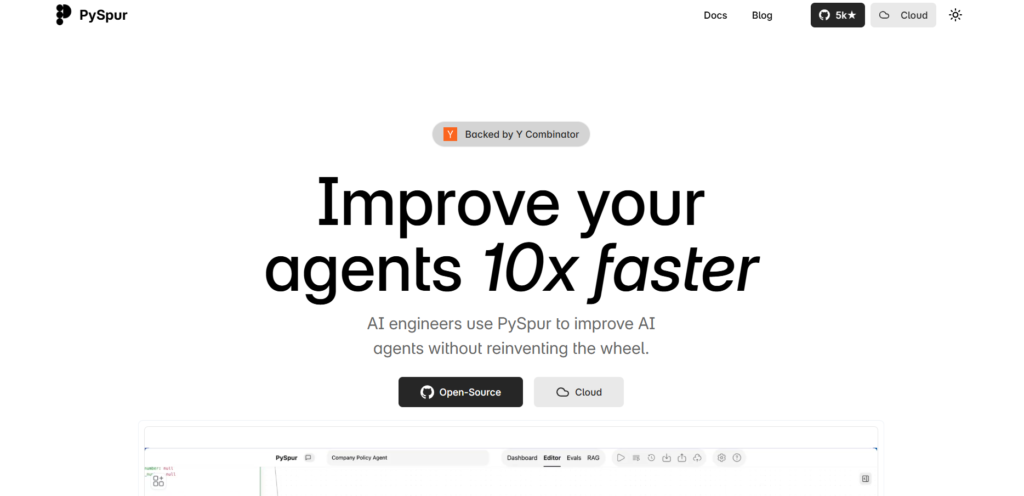
Key Features:
- Node-based workflow builder: Visually connect logic, APIs, models, and conditionals without coding.
- Manual review integration: Add breakpoints for human approval or inspection at any step.
- Built-in test case management: Define input-output test cases to simulate agent behavior before deployment.
- Cloud & on-prem deployment: Offers enterprise-friendly deployment flexibility.
- Completely free and open-source.
Ideal For:
- Tech-savvy users looking for control over each step.
- Research teams prototyping AI logic flows.
- Enterprises seeking human-reviewed automation pipelines.
Standout Quality:
The ability to test and debug AI workflows with fine-grained control makes PySpur a favorite among advanced users who want transparency and traceability in AI behavior.
2. MindStudio – Rapid Prototyping with Multimodal Capabilities
Overview:
MindStudio is a cloud-based visual AI builder designed for speed, simplicity, and versatility. Its drag-and-drop interface, combined with support for language, image, and voice models, makes it one of the most comprehensive platforms for building AI-native agents. From customer support bots to creative content assistants, MindStudio supports a wide range of use cases.
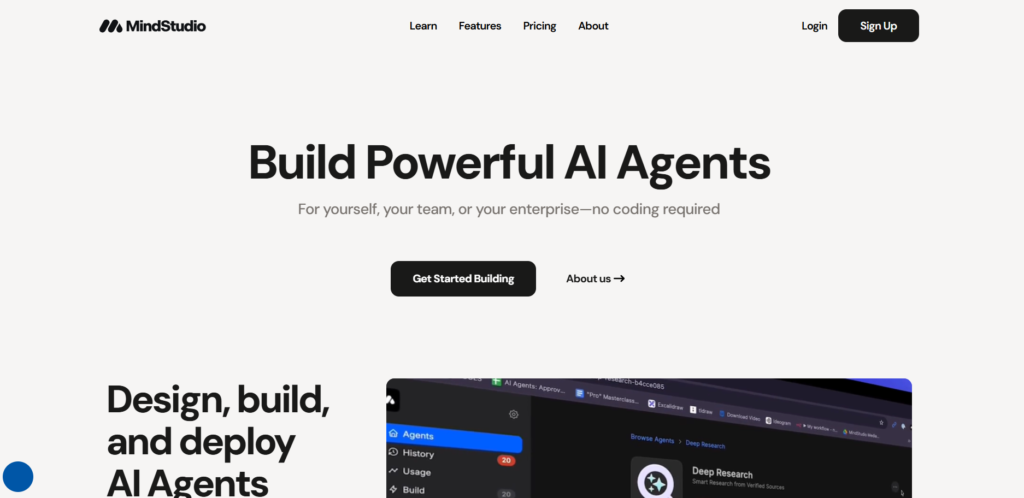
Key Features:
- Multimodal agent construction: Combine text, images, voice, and vision models.
- Over 100 prebuilt templates: Get started with common business and personal applications in under an hour.
- Cross-platform deployment: Publish as web apps, browser extensions, or REST APIs.
- SOC II compliant: Trusted by organizations with strict data privacy requirements.
- Hybrid extensibility: While no-code is the default, developers can optionally inject code for advanced customization.
Ideal For:
- Startups building MVPs.
- Product teams experimenting with customer-facing AI tools.
- Organizations with privacy and compliance needs.
Standout Quality:
MindStudio’s multimodal agent support and speed of deployment (15–60 minutes to build) make it one of the most efficient tools for real-world applications.
3. Dify – Open-Source AI Agent Platform with Team Collaboration
Overview:
Dify is an all-in-one platform for building, managing, and iterating AI agents—offering a full-stack experience from visual canvas to backend deployment. What sets Dify apart is its emphasis on collaboration, allowing teams to co-build and review agent logic in real-time. It’s ideal for businesses and research groups looking for a shared space to develop intelligent applications.
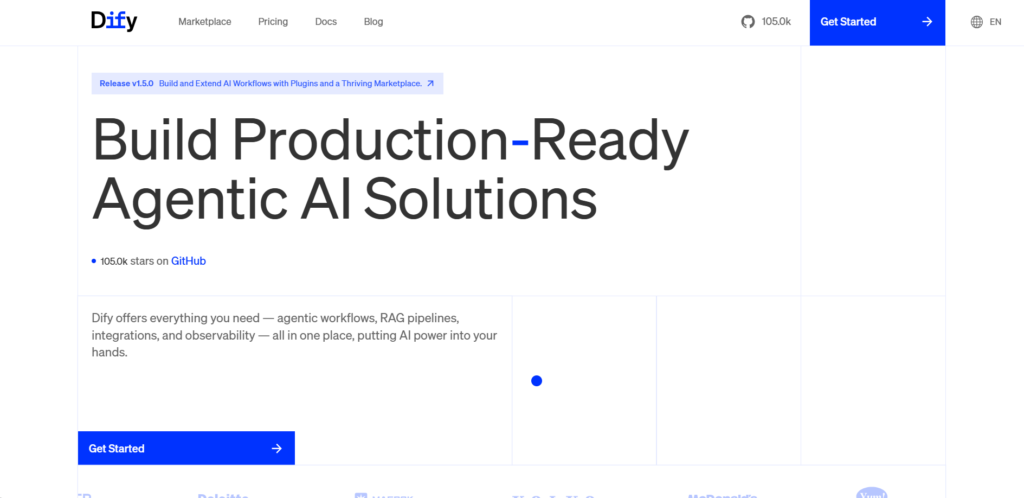
Key Features:
- Drag-and-drop visual builder: Rapidly design agentic workflows, RAG pipelines, and multi-step operations.
- Model and prompt management: Tweak LLM parameters, temperature, and context per step.
- Observability tools: Monitor inputs, outputs, and performance metrics.
- Open-source with commercial-friendly licensing.
- Team collaboration: Shared access and version control for multi-user teams.
Ideal For:
- Teams managing AI application lifecycle together.
- Developers needing fine control over LLM parameters.
- Open-source adopters building on a shared codebase.
Standout Quality:
Dify’s combination of agent orchestration and team collaboration fills the gap between simple chatbots and complex enterprise AI systems.
4. Langflow – The Visual IDE for Building Multi-Agent Systems
Overview:
Langflow positions itself as a developer-centric no-code tool that enables the creation of multi-agent workflows using large language models (LLMs). With a powerful visual IDE, Langflow supports plug-and-play integration with virtually any API, vector database, or AI service. It excels in creating Retrieval-Augmented Generation (RAG) systems and autonomous agent chains.

Key Features:
- Flow-based UI: Drag and drop components like memory, tools, databases, and triggers.
- Interoperability with any LLM/API: Hugging Face, OpenAI, Cohere, Pinecone, Weaviate, and more.
- Pre-built flow templates: Rapid prototyping for customer service, document QA, chatbot assistants, etc.
- Support for real-time feedback loops and RAG configurations.
- Fully open-source with active development.
Ideal For:
- Builders of search engines, autonomous research agents, and document-based assistants.
- Developers exploring multi-agent architectures.
- Teams needing quick experimentation with different models.
Standout Quality:
Langflow’s model-agnostic and multi-agent support makes it a powerful option for complex real-time decision-making systems.
5. Flowise – From Simple LLM Apps to Enterprise Multi-Agent Workflows
Overview:
Flowise is one of the most scalable platforms on this list, bridging the gap between single-user chatbots and enterprise-grade multi-agent orchestration systems. With a modular structure, Flowise allows users to chain together LLM components, integrate API calls, set up human approvals, and implement branching logic—all in a no-code interface.
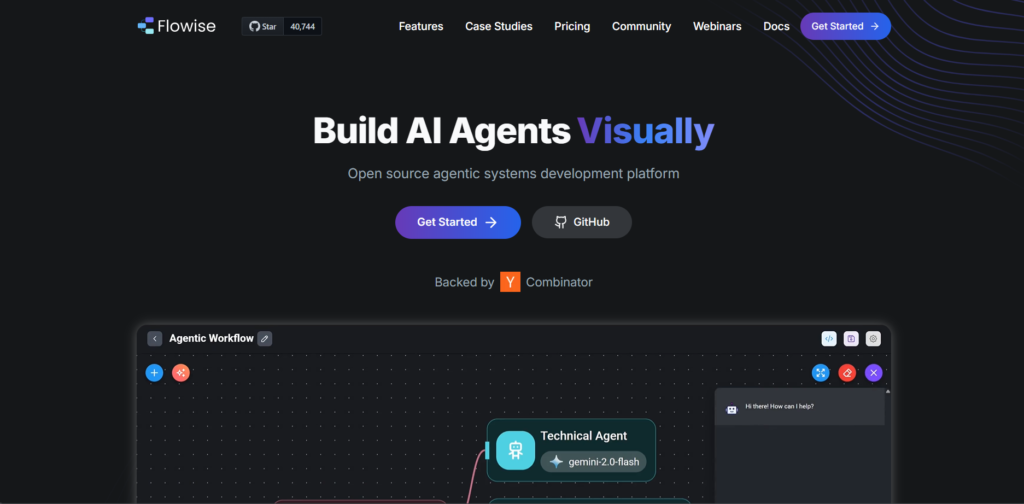
Key Features:
- Flexible orchestration: Supports linear, parallel, and conditional branching workflows.
- Custom UI generation: Deploy agents as chat UIs, APIs, or embedded assistants.
- Supports hybrid workflows: Combine RAG, tool use, memory modules, and context switching.
- Security and scalability: Run securely in enterprise or cloud environments.
- Optional integration of human approval gates.
Ideal For:
- Enterprises designing customer-facing AI agents.
- AI-powered internal tools and dashboards.
- Multi-modal workflows and content generation pipelines.
Standout Quality:
Flowise excels in enterprise deployment, offering modularity, fine-grained control, and robust infrastructure compatibility.
Quick Comparison Table
| Platform | Open Source | Drag & Drop | Multi-Agent Support | Deployment Options | Ideal For |
|---|---|---|---|---|---|
| PySpur | ✅ | ✅ | 🚫 | Cloud, On-Prem | Debugging-focused workflows |
| MindStudio | 🚫 | ✅ | 🚫 | Web App, API, Extension | Creative apps, fast prototyping |
| Dify | ✅ | ✅ | ✅ | Self-hosted or cloud | Team collaboration, LLM tuning |
| Langflow | ✅ | ✅ | ✅ | Custom Hosting, GitHub repo | Multi-agent RAG applications |
| Flowise | ✅ | ✅ | ✅ | Enterprise, On-Prem, Cloud | Full-scale AI applications |
Conclusion: AI Building for Everyone
The rise of no-code platforms like PySpur, MindStudio, Dify, Langflow, and Flowise signals a major shift in how AI is built and deployed in 2025. These tools aren’t just simplifying development—they’re empowering a new generation of AI creators across marketing, education, research, healthcare, customer service, and beyond.
Whether you’re launching a personal assistant, scaling up an enterprise-grade agent, or exploring multi-agent research tools, there’s now a no-code platform that meets your needs—without sacrificing power, flexibility, or customizability.
Ready to build your first AI agent?
Start experimenting with these platforms to bring your ideas to life—no coding required. Discover the best AI Agents of 2025 in the AI Toolhouse AI Agents directory.

